Georgia Cave Towns
Cave towns are captivating aspects of Georgia’s history that hold great significance. In Georgia, you will discover three unique rock-cut complexes: Uplistsikhe, Vardzia, and David Gareja. By visiting these ancient settlements, we can understand their historical importance and admire the incredible skill and effort put into building them.
The practical advantages of cave dwellings played a vital role in the survival of these communities. The caves also provided insulation, keeping a stable temperature inside and helping people cope with extreme weather.
In addition to their practicality, cave towns held cultural and religious significance. They served as central hubs for community life, creating a strong bond between residents and their surroundings. The caves served as sacred spaces for rituals and gatherings, deepening the connection between people and the environment.
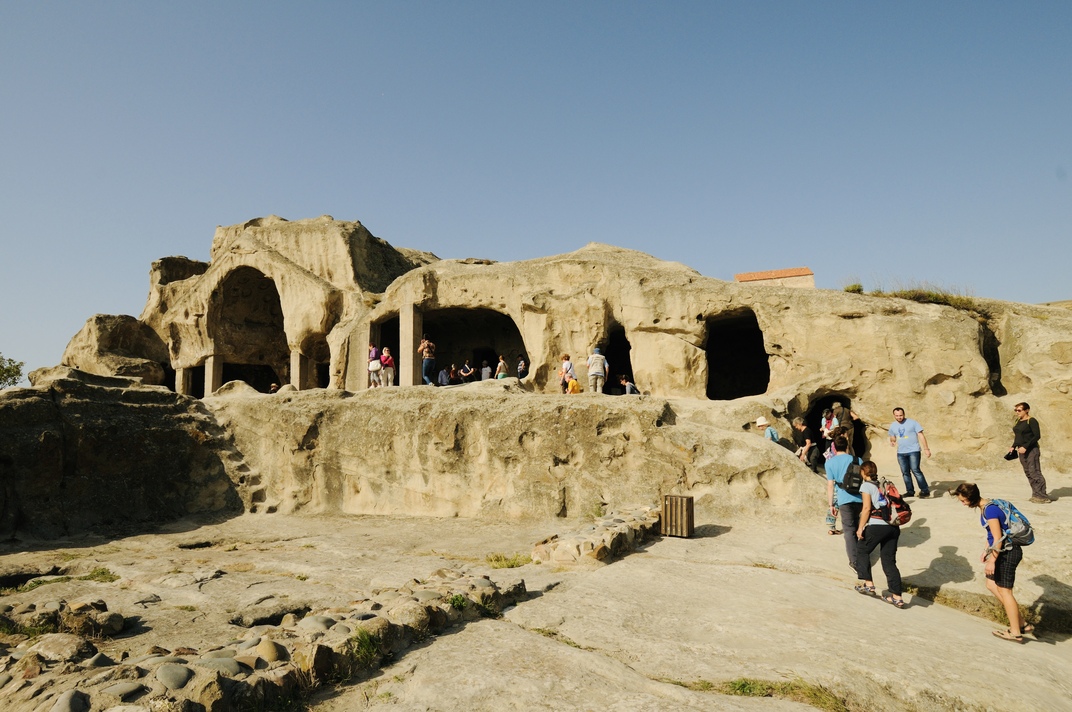
Uplistsikhe: The Oldest Cave Town in Georgia
Welcome to Uplistsikhe, the ancient cave town located just 10 kilometers east of the city of Gori in Georgia, which dates back to the 6th-4th centuries BC, making it a remarkable historical site.
A main highlight of Uplistsikhe is the awe-inspiring rock-cut dwellings, situated on a rocky plateau overlooking the Mtkvari River. These ancient homes, carved directly into the cliffs, provide a glimpse into the daily lives of the town’s inhabitants. Visitors can freely wander through the detailed chambers, rooms, and pathways of these incredible homes carved from rocks, and appreciate the cleverness and skill of the people who created them.
The amphitheater of Uplistsikhe is another remarkable feature for travelers to explore. This open-air venue once hosted gatherings, performances, and communal events, reflecting the vibrant social life that once thrived in the cave town. In the ceiling of the amphitheater, you will find Roman elements – a caisson ceiling, which indicates that the Hellenistic culture was widespread here as well.
Discover an ancient pharmacy store at Uplistsikhe, revealing ancient wisdom in medicine. This site served as a hub for healing herbs and remedies showcasing their dedication to well-being. Furthermore, the ancient residents ingeniously gathered water through a well-designed plumbing system, ensuring a steady water supply for their daily needs.
In Uplistsikhe, many winepresses and cellars show the locals’ involvement in wine production. Despite the rocky terrain making vineyards impossible, seven winepresses and cellars were found. Grapes were likely brought elsewhere to be pressed in this unique location. During medieval times, Uplistsikhe was a prosperous town with 20,000 inhabitants. You might be surprised where so many people fit. Well, the secret lies in the presence of around 700 caves spread throughout the town’s area, and people were also settled around the city.
Uplistsikhe has another entrance – a secret tunnel. It rises from the bank of Mtkvari in the southern part of the city, is completely carved out of the rock, and has a circular shape in the cut. The lower entrance is cleverly camouflaged, often unnoticed by passengers on the road.
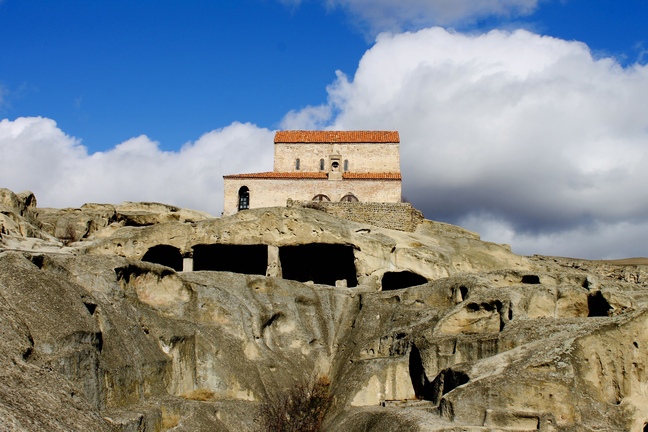
Traveling tips for Uplistsikhe
If you plan to visit Uplistsikhe, it’s advisable to leave Tbilisi early to avoid traffic. From Tbilisi, it’s 78 kilometers, and the journey usually takes around half an hour. Wear comfortable shoes for walking on uneven stone surfaces and consider a hat for sun protection. Exploring the cave town typically takes 1.5 to 2 hours, so bring a water bottle with you.

Where to relax
After an exciting trip, travelers can unwind and savor delectable Georgian cuisine in Gori. Indulge in local dishes like Khabizgina (potato-filled Khachapuri), Chakhrakina (beet greeny pie), and Goruli Cutlet (roasted meat).
Discover Cave Towns of Georgia
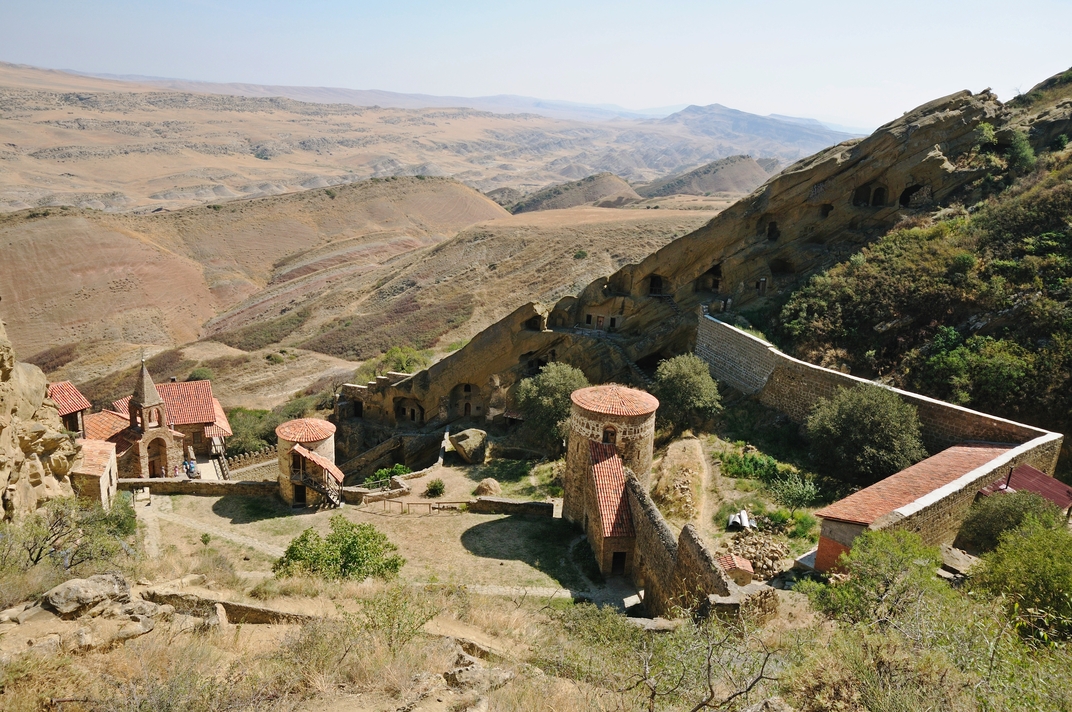
David Gareja: The Monastic Complex in the Desert
David Gareja, an active monastery located in Kakheti within the Sagarejo Municipality, is the second rock-cut complex worth visiting. Monastery was founded by the Assyrian monk David in the early 6th century and served as a significant center for spirituality and learning.
On the way to the monastery, you’ll encounter various-sized brackish lakes formed by the unique local climate and soil mineralization. The colorful “Rainbow Mountains” served as evidence, with abundant Hematite giving the soil a red hue and Limonite imparting a yellow shade. These minerals were extensively used in the middle ages painting school of David Gareja.
The nature and landscape here are extraordinary, serving as a paradise for Ornithologists observing various bird species such as Saker Falcon, Eastern imperial eagle, Eurasian griffon vulture, Egyptian vulture, Galbeolus, and Ruddy shelduck. David Gareja’s flora captivates Botanical enthusiasts as diverse plants have adapted to the dry environment. From tough shrubs and strong grasses to unique desert herbs and wildlife, these plants have fascinating water-saving adaptations.
The first monastery founded by David is “Lavra of David”, it is easily accessible and everyone will be able to visit it. It’s known for its remarkable rock-hewn structure, including churches, cells, and chapels. The monastery has served as a center for religious and cultural activities for centuries, attracting pilgrims and visitors alike. If you go down the stairs, you will find David’s small room where he lived.
From the 9th century onwards, the Gareji monasteries played a multifaceted role influenced by Byzantine traditions. They fostered Christian faith, education, and the growth of culture and art. Monasteries served as centers for writing and copying theological books, including the lives of saints.
David-Gareja is located on the border with Azerbaijan, 4 monasteries are on the territory of Azerbaijan. Unfortunately, as a result, travelers cannot explore the other monasteries as the state border passes directly through the monastery’s land.
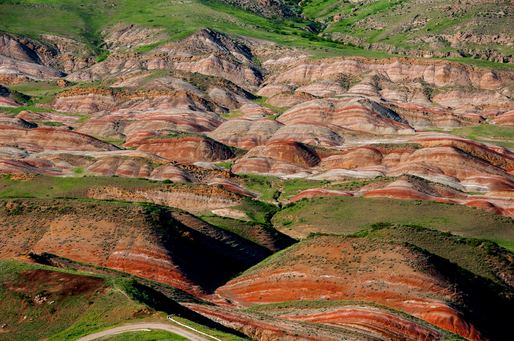
Traveling tips for David Gareja
It’s about a 1.5-hour car journey from Tbilisi to David Gareja. When visiting, remember to dress modestly due to the monastery’s active status. Also, it’s a good idea to bring sunscreen and water with you when you travel. Grassy areas may harbor risky reptiles, so be careful while walking.
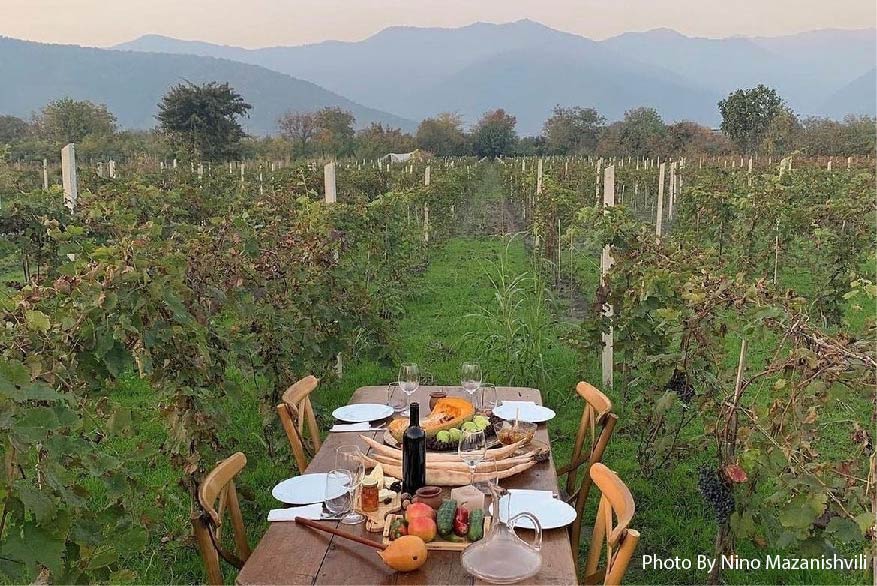
Where to relax
For those continuing their journey, Kakheti, known as the cradle of wine, is an ideal destination. History and wine enthusiasts should explore Kvareli and Telavi, where delightful experiences await. Savor exquisite wines and traditional local cuisines like Mtsvadi (barbecue), Tschaqafuli (meat stew), and Shotis Puri (Georgian bread).
Discover Cave Towns of Georgia
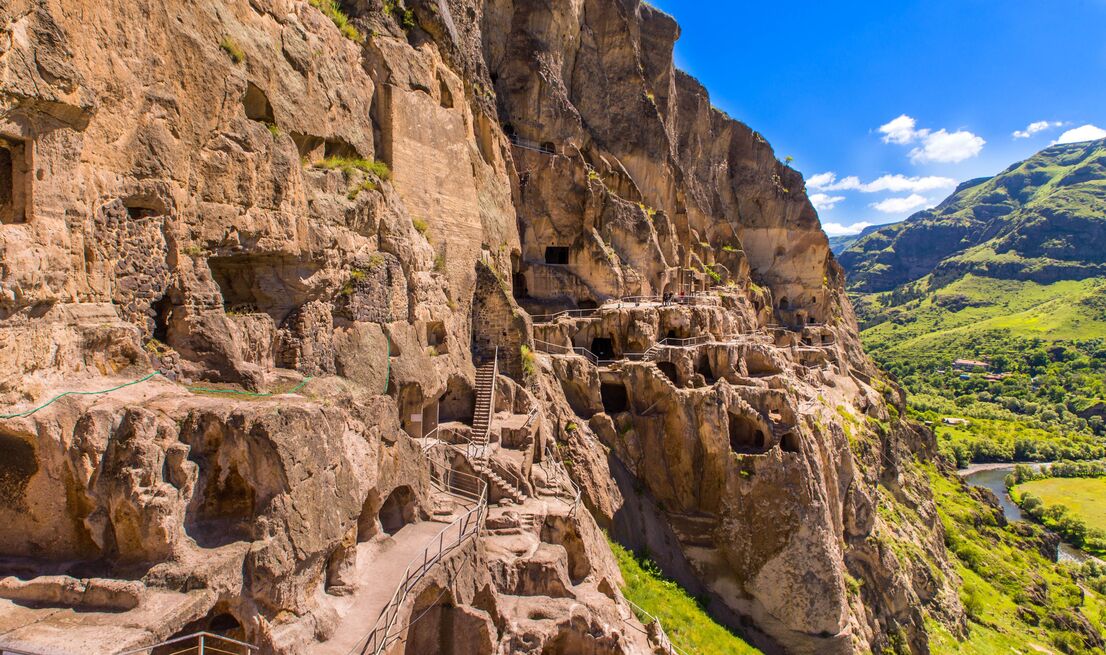
Vardzia: The Cave Monastery Complex
To explore the Vardzia monastery complex, embark on a trip to Georgia’s Samtskhe-Javakheti region, known for its diverse natural beauty. Vardzia cave complex is especially large-scale among the rock-carved cities in Georgia and can be easily seen from afar. With a history dating back to the 12th century, this remarkable site, founded by the visionary Queen Tamar, continues to enchant visitors with its fascinating past and awe-inspiring architecture.
Vardzia is a clear confirmation of how Georgia became stronger in the twelfth century, which is known as the Golden Age. Today, more than 1/6 of the original complex remains and still amazes the visitor with its beauty, scale, and architectural solution. The place accommodated about 50,000 inhabitants, initially, there were about 3000 caves in the complex, and now their number is about 550. In Vardzia there were living quarters, dining rooms, food storage barns, wine cellars, stables, a pharmacy, a library, and all other conditions necessary for life. Also, Vardzia was perfectly provided with drinkable water.
The complex of Vardzia was invisible from the front because it was covered by a thick layer of rock, this layer soon collapsed as a result of the earthquake, and Vardzia also lost its importance as a secret city. Vardzia has a large network of internal tunnels, providing an exciting opportunity for travelers to explore. These fascinating tunnels run through the cave complex, uncovering hidden rooms, connecting different parts, and creating an atmosphere of intrigue.
Make sure to visit the Cathedral of the Assumption of the Virgin Mary at the heart of the Vardzia complex. Although small, the church boasts 17 remarkable paintings. As Vardzia is an active monastery, it’s important to respect religious and cultural customs when entering the church: men should cover their legs, and women should wear long skirts and cover their hair.
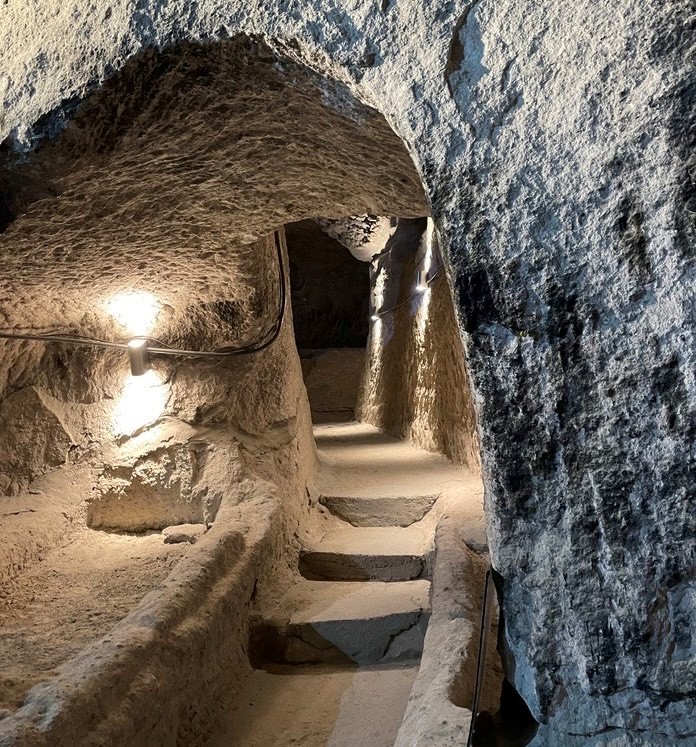
Traveling tips for Vardzia
From Tbilisi, it takes about 4 to 5 hours by road to reach Vardzia. Due to limited transportation options, many prefer organized day tours. Vardzia is situated in a remote area, and to reach the monastery complex, you may need to walk a certain distance. Bring comfortable shoes, water, and snacks for the journey. Visiting the entire complex typically lasts 1.5 to 2 hours.
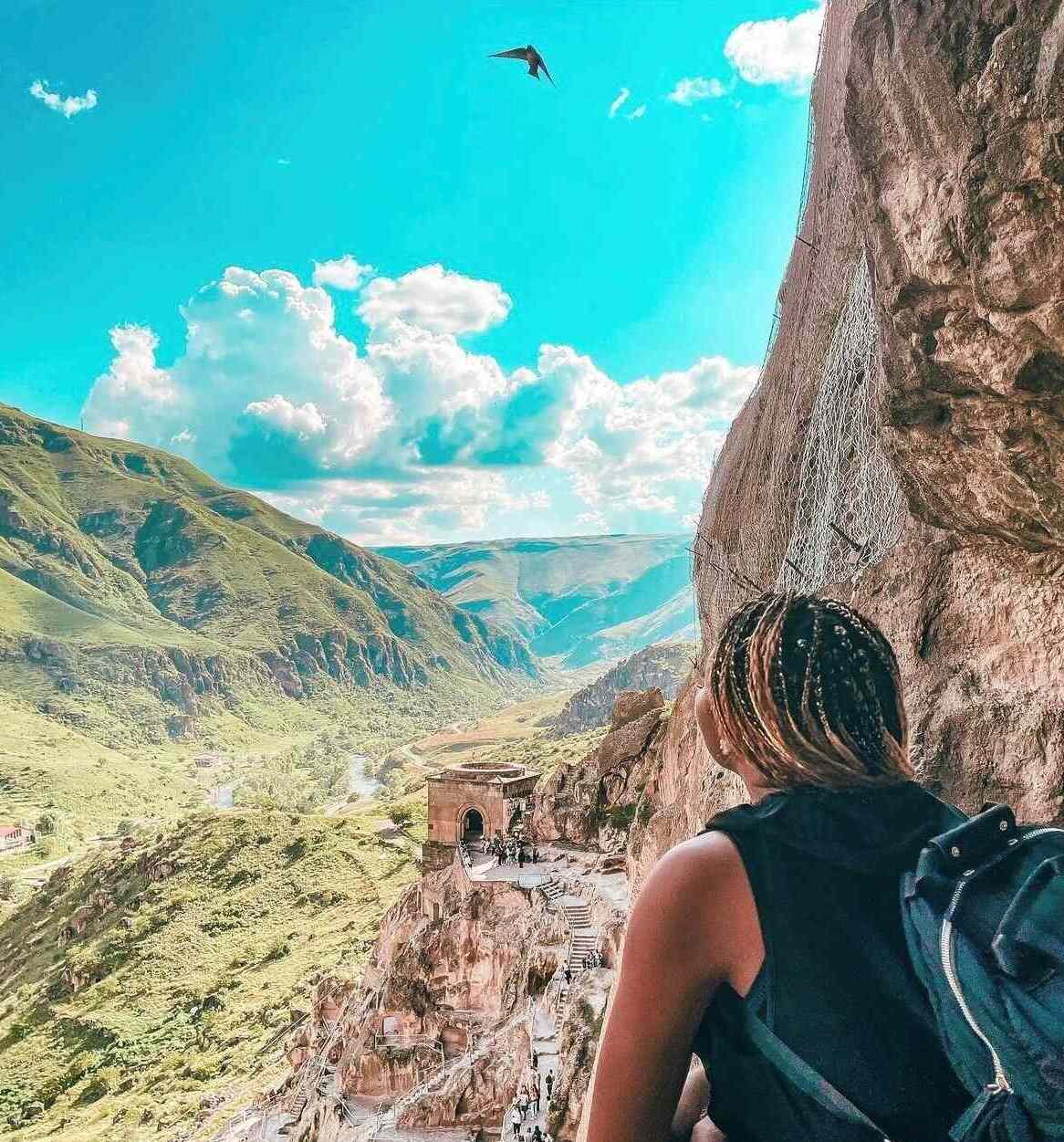
Where to relax
Unwind and dine in Akhaltsikhe, a significant town in the Samtskhe-Javakheti region, 60 km from Vardzia cave town. Try dishes like Fried trout, Meskhuri Qada (bread filled with lard and flour), Tenili cheese (preserved, hand-pulled cheese), and Apokhti (dried meat).
Expert adviseDiscover more through our tours
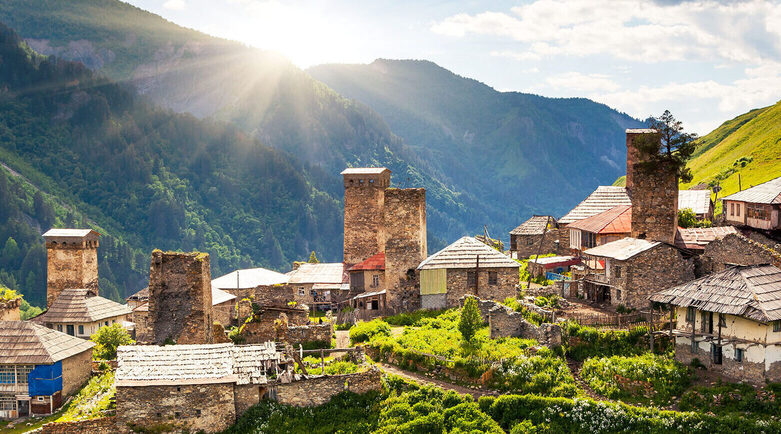
County of Wonders
Georgia is a country of endless discoveries. There are many reasons why traveling to this small country is genuinely worthwhile: untouched nature and wildlife, ancient cities, monasteries, centuries-old towers.